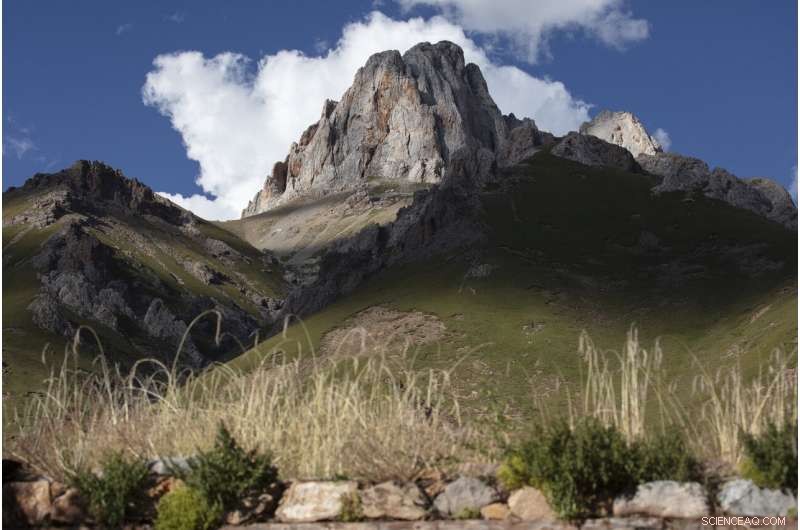
Les pics s'élèvent vers le ciel en Angsai, dimanche dans une zone de la région de Sanjiangyuan, dans la province chinoise du Qinghai (ouest), 25 août, 2019. Entouré des plus hautes chaînes de montagnes du monde, la région longtemps connue comme « le toit du monde » est maintenant dans le collimateur de la dernière poussée de modernisation de la Chine. Mais cette fois, le gouvernement chinois veut fixer des limites à la croissance de la région afin de mettre en œuvre sa propre version de l'un des héritages les plus fiers des États-Unis :un système de parcs nationaux. (Photo AP/Ng Han Guan)
Il y a un boom de la construction sur le plateau tibétain, l'un des derniers endroits reculés du monde. Les montagnes longtemps couronnées de guirlandes de drapeaux de prière flottants - une bénédiction traditionnelle du paysage - sont nouvellement surmontées de lignes électriques tentaculaires en acier. La nuit, les enseignes lumineuses des stations-service Sinopec jetaient une lueur rouge sur les autoroutes nouvellement construites.
Entouré des plus hautes chaînes de montagnes du monde, la région longtemps connue sous le nom de « le toit du monde » est désormais dans le collimateur de la dernière campagne de modernisation de la Chine, marqué par la multiplication des gratte-ciel et l'expansion des lignes ferroviaires à grande vitesse.
Mais cette fois, il y a une différence :le gouvernement chinois veut également fixer des limites à la croissance de la région afin de concevoir sa propre version de l'un des héritages les plus fiers des États-Unis :un système de parcs nationaux.
En août, décideurs et scientifiques de Chine, les États-Unis et d'autres pays réunis à Xining, capitale de la province du Qinghai, pour discuter des plans de la Chine pour créer un système de parcs unifié avec des normes claires pour limiter le développement et protéger les écosystèmes.
L'économie du pays a explosé au cours des 40 dernières années, mais les priorités s'élargissent désormais pour inclure la conservation des ressources naturelles clés, dit Zhu Chunquan, le représentant chinois de l'Union internationale pour la conservation de la nature, un groupe scientifique basé en Suisse.
« Il est assez urgent d'identifier au plus vite les lieux, les écosystèmes et autres caractéristiques naturelles" à protéger, dit Zhu.

Une femme tibétaine s'occupe d'un enfant à Angsai, dimanche dans une zone de la région de Sanjiangyuan, dans la province chinoise du Qinghai (ouest), 25 août, 2019. Une question clé plane sur le projet de parcs nationaux du pays :la Chine peut-elle marier les objectifs de conservation et de tourisme ? tout en préservant les moyens de subsistance et la culture des quelque 128, 000 personnes qui vivent à l'intérieur ou à proximité des limites du parc, beaucoup d'entre eux tibétains ? (Photo AP/Ng Han Guan)
Entre autres objectifs, La Chine vise à construire son propre Yellowstone sur le plateau tibétain.
Zhu fait partie d'un comité consultatif fournissant des commentaires sur le développement du système de parcs nationaux naissant de la Chine, devrait être officiellement dévoilé en 2020. Des responsables chinois ont également visité des parcs nationaux américains, y compris Yellowstone et Yosemite, et sollicité l'apport de diverses organisations, y compris le Paulson Institute basé à Chicago et le Nature Conservancy.
L'ambition de créer un système de parcs unifié représente « un nouvel effort sérieux pour sauvegarder la biodiversité et le patrimoine naturel de la Chine, ", explique l'écologiste de l'Université Duke, Stuart Pimm.
L'un des premiers parcs pilotes sera au Qinghai, une vaste région de l'ouest de la Chine jouxtant le Tibet et partageant une grande partie de son héritage culturel. La région abrite également des espèces emblématiques et menacées comme le léopard des neiges et le chat des montagnes chinois, et englobe les sources de trois des grands cours d'eau d'Asie :le Yangtze, Fleuves Jaune et Mékong.
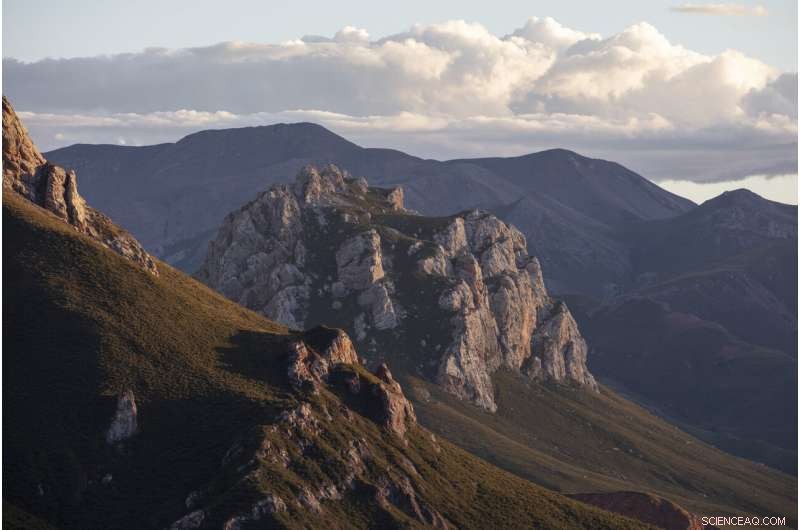
Les nuages planent sur le paysage montagneux de l'Angsai, dimanche dans une zone de la région de Sanjiangyuan, dans la province chinoise du Qinghai (ouest), 25 août, 2019. La Chine vise à construire son propre Yellowstone sur le plateau tibétain. (Photo AP/Ng Han Guan)
"C'est l'une des régions les plus spéciales de Chine, dans le monde, " dit Lu Zhi, un biologiste de la conservation de l'Université de Pékin qui a travaillé au Qinghai pendant deux décennies.
Alors que la construction se poursuit à un rythme effréné ailleurs sur le plateau tibétain, le gouvernement a déjà cessé de délivrer des permis miniers et hydroélectriques dans cette région.
Mais une question clé plane sur le projet :la Chine peut-elle marier les objectifs de conservation et de tourisme, tout en préservant les moyens de subsistance et la culture des quelque 128, 000 personnes qui vivent à l'intérieur ou à proximité des limites du parc, beaucoup d'entre eux tibétains ?
« La Chine a une population dense et une longue histoire, " dit Zhu. "L'une des caractéristiques uniques des parcs nationaux chinois est qu'ils ont des habitants qui vivent à l'intérieur ou à proximité."
Yellowstone est largement considéré comme le premier parc national au monde. Après sa création en 1872, le gouvernement américain a forcé les Amérindiens qui vivaient dans la région à se réinstaller en dehors des limites du parc, conformément à la notion du XIXe siècle selon laquelle la protection de la nature sauvage signifiait la nature séparée des gens. Mais les pays qui tentent d'établir des systèmes de parcs au 21e siècle doivent maintenant réfléchir à la meilleure façon d'inclure les populations locales dans leur planification.
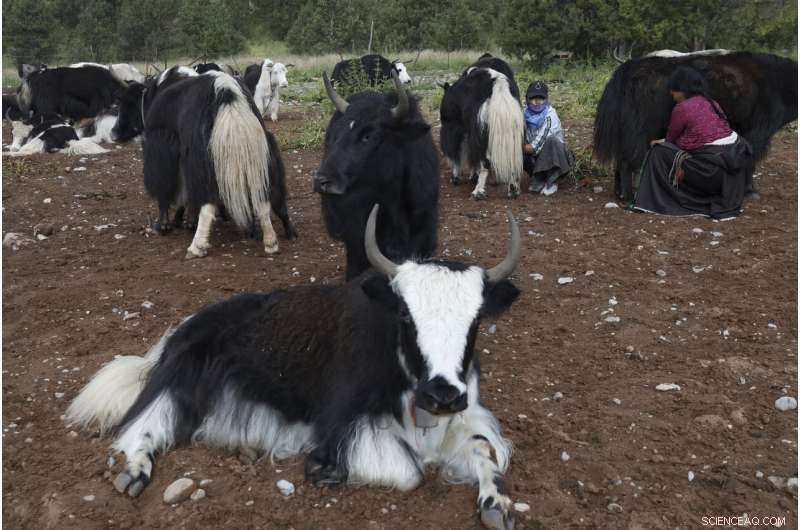
Les femmes tibétaines traient leurs yaks à Angsai, dimanche dans une zone de la région de Sanjiangyuan, dans la province chinoise du Qinghai (ouest), 25 août, 2019. Le Qinghai est une vaste région de l'ouest de la Chine jouxtant le Tibet et partage une grande partie de son héritage culturel. (Photo AP/Ng Han Guan)
« Comment parvenir à la conservation écologique et au soutien des communautés en même temps, c'est le problème le plus compliqué que vous ayez, " dit Jonathan Jarvis, ancien directeur du National Park Service des États-Unis et maintenant professeur à l'Université de Californie, Berkeley, qui a visité le parc pilote du Qinghai, appelé Sanjiangyuan.
La Chine a déjà entrepris de vastes programmes de réinstallation pour défricher des terres pour de grands projets d'infrastructure, tels que le barrage des Trois Gorges et le projet de transfert d'eau sud-nord. Ces réinstallations ont laissé de nombreux agriculteurs dans de nouvelles maisons sans champs agricoles appropriés ni accès à d'autres moyens de subsistance.
Mais en développant les parcs nationaux, le gouvernement offre des emplois liés à la conservation à au moins un groupe de personnes vivant à Sanjiangyuan pour qu'elles restent et travaillent sur leurs terres. The "One Family, One Ranger" program hires one person per family for 1800 yuan a month ($255) to perform such tasks as collecting trash and monitoring for poaching or illegal grazing activity.
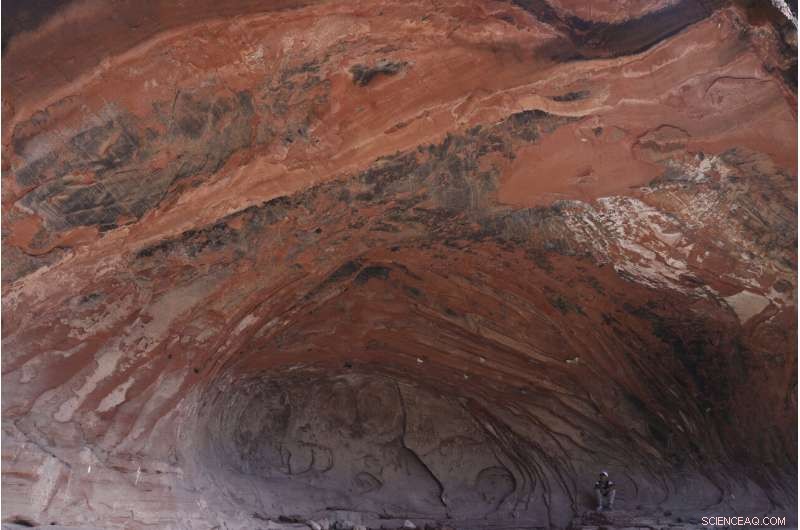
A Tibetan youth sits at the base of a natural cave formation in Angsai, an area inside the Sanjiangyuan region in western China's Qinghai province on Sunday, Aug. 25, 2019. China has previously undertaken vast resettlement programs to clear land for large infrastructure projects, but in developing the national parks, the government is giving conservation-related jobs to at least a swath of people living in Sanjiangyuan to stay and work on their land. (AP Photo/Ng Han Guan)
It's difficult to interview residents in China's ethnic borderlands like Qinghai, due to restrictions on journalists that make it hard to travel widely or freely in those areas. Regions with large ethnic and religious minorities, including all Tibetan areas, are subject to heightened political and religious controls.
But a few people living in Angsai, a Tibetan village located within the new Qinghai park, were willing to speak, although it's not possible to determine if their experiences are typical.
A-Ta is a Tibetan herder whose income largely comes from raising yaks and collecting caterpillar fungus, a folk medicine taken as a purported aphrodisiac or for respiratory problems. He also leads a team of trash collectors, traveling as much as 34 kilometers (21 miles) a day to comb the hillsides for plastic bottles and other waste as part of the "One Family, One Ranger" program.

A-Ta, at right stands near his father in their home in Angsai, an area inside the Sanjiangyuan region in western China's Qinghai province on Monday, Aug. 26, 2019. A-Ta, a Tibetan herder whose income largely comes from raising yaks and collecting caterpillar fungus, also leads a team of trash collectors traveling as much as 34 kilometers (21 miles) a day to comb the hillsides for plastic bottles and other waste, as part of the "One Family, One Ranger" program. (AP Photo/Ng Han Guan)
"I am living in this land, my living is relying on this land, " il dit, as his sister heats a kettle in their modest home. A poster showing the faces of China's past leaders and current Communist Party general secretary, Xi Jinping, hangs on the wall.
A-Ta says he is grateful for work that allows his family to stay on their land, even as people in other parts of Qinghai have had to leave. His own son is employed leading a relocation program for "a huge population of nomads" in Dzarto, a county in southern Qinghai.
"I love this land very much, " he says. "I always motivate and encourage people to protect the environment and contribute to the conservation work."
Kunchok Jangtse is a Tibetan herder who also earns money cleaning up rubbish through the "One Family, One Ranger" program.
He has an additional volunteer position through the Chinese nonprofit Shanshui—the name means "mountain, water"—installing and maintaining motion-activated camera traps, which help scientists monitor endangered species in Qinghai.
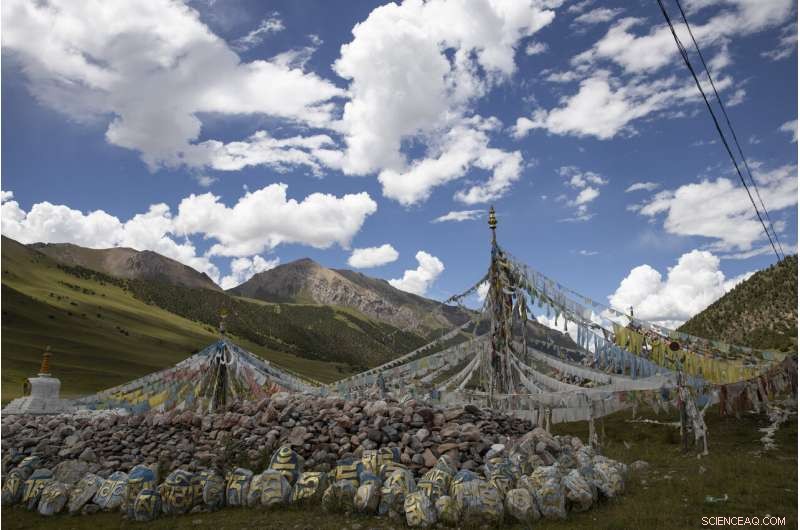
Tibetan prayer flags are seen during a clear day in Angsai, an area inside the Sanjiangyuan region in western China's Qinghai province on Monday, Aug. 26, 2019. Qinghai is a vast region in western China abutting Tibet and shares much of its cultural legacy. (AP Photo/Ng Han Guan)
As he affixes a camera trap to a thin tree trunk, he explains, "The reason why it has to be installed in this location is because this is the main migration route of the majority of wild animals."
Such camera traps have captured rare footage of snow leopards and Chinese mountain cats, including mothers and their cubs playing near a temporary den.
Kunchok Jangtse says the work of protecting the environment, including reporting illegal poaching activity, is important.
"Our religion is connected with wild animals, because wild animals have a consciousness and can feel love and compassion—therefore, we protect wild-animals, " il dit.
From his main work raising livestock and collecting caterpillar fungus, Kunchok Jangtse says he can make about 20, 000 yuan ($2, 830) a year. He is grateful for the additional income from the ranger program, but mainly hopes his other livelihood won't be impeded—and that he won't eventually be forced to leave.
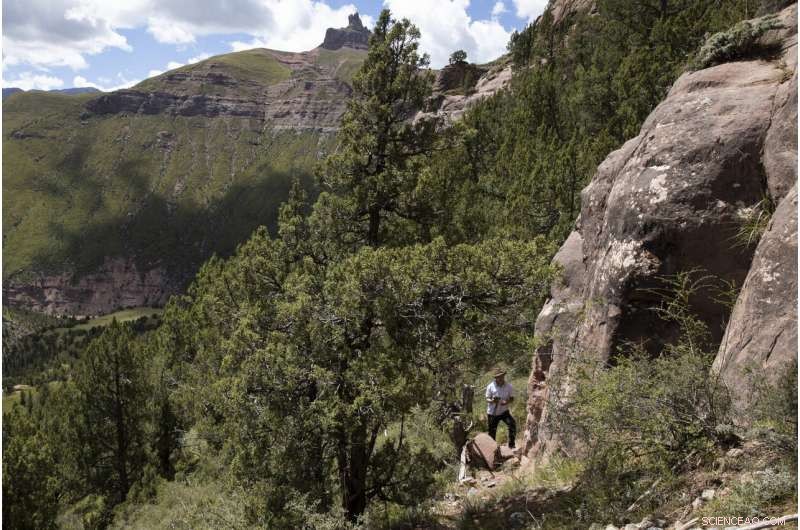
Kunchok Jangtse, a Tibetan herder who also instals and maintains motion-activated cameras, works on a camera in Angsai, an area inside the Sanjiangyuan region in western China's Qinghai province on Tuesday, 27 août 2019. His work helps scientists monitor endangered species. "I'm not a highly educated person, and I am very concerned it may bring many difficulties in my life if I would switch my job and move to another place, " he says. (AP Photo/Ng Han Guan)
"I'm not a highly educated person, and I am very concerned it may bring many difficulties in my life if I would switch my job and move to another place, " il dit.
The question of local people's culture and livelihoods is one of the top concerns that former U.S. National Park Service director Jarvis says China has to wrestle with, along with establishing laws and funding.
"They need a legal framework that defines what a park is, " Jarvis says. "And they need sustainable funding."
The creation of protected areas is not a new idea in China. En réalité, roughly 15% of the country's land already is assigned to a bewildering patchwork of local and regional parks. But many existing reserves are simply parks on paper, run by various agencies without enforceable guidelines.
En revanche, the national parks system is being designed from the ground-up to incorporate global best practices and new science.
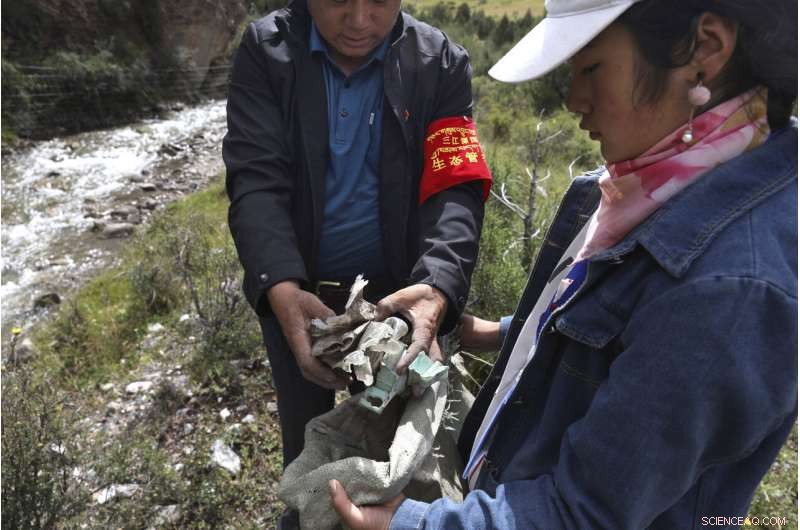
A-Ta, a Tibetan herder whose income largely comes from raising yaks and collecting caterpillar fungus, places refuse in a bag as he leads his team of trash collectors in Angsai, an area inside the Sanjiangyuan region in western China's Qinghai province on Monday, Aug. 26, 2019. His team travels as much as 34 kilometers (21 miles) a day to comb the hillsides for plastic bottles and other waste, as part of the "One Family, One Ranger" program. "I am living in this land, my living is relying on this land, " he says. (AP Photo/Ng Han Guan)
In his office in Beijing, Ouyang Zhiyun, deputy director at the Chinese Academy of Sciences' Research Center for Eco-Environmental Sciences, pores over hundreds of carefully shaded maps of mainland China that denote priority areas for protecting threatened and endangered species, as well as "eco-system services, " like safeguarding water supplies and limiting soil erosion.
The question isn't just how much total land you're protecting, but which lands you're protecting, he notes.
Récemment, Ouyang was the lead scientist for China's sweeping "national ecosystems assessment, " which used 20, 000 satellite images and 100, 000 field surveys to examine how China's land changed between 2000 and 2010, with some of the findings published in the journal Science in 2016. One resulting statistic:China's urban area increased 28% during that period.
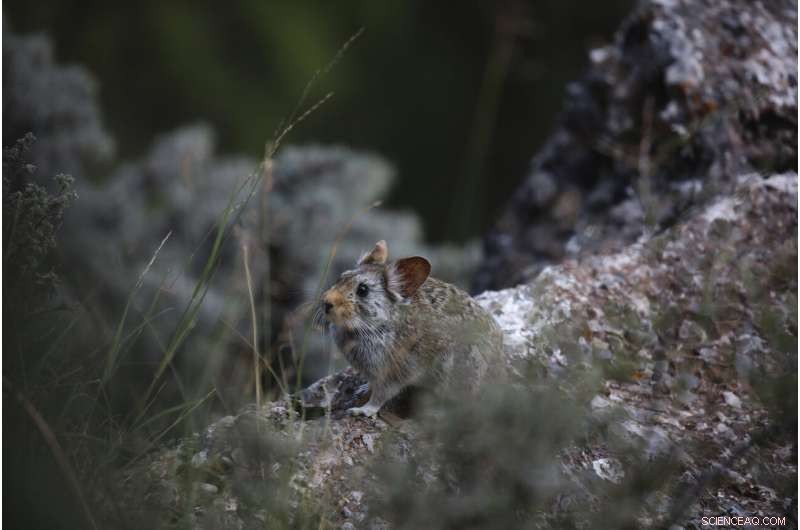
A Glover's Pika surveys its surrounding in Angsai, an area inside the Sanjiangyuan region in western China's Qinghai province on Tuesday, 27 août 2019. (AP Photo/Ng Han Guan)
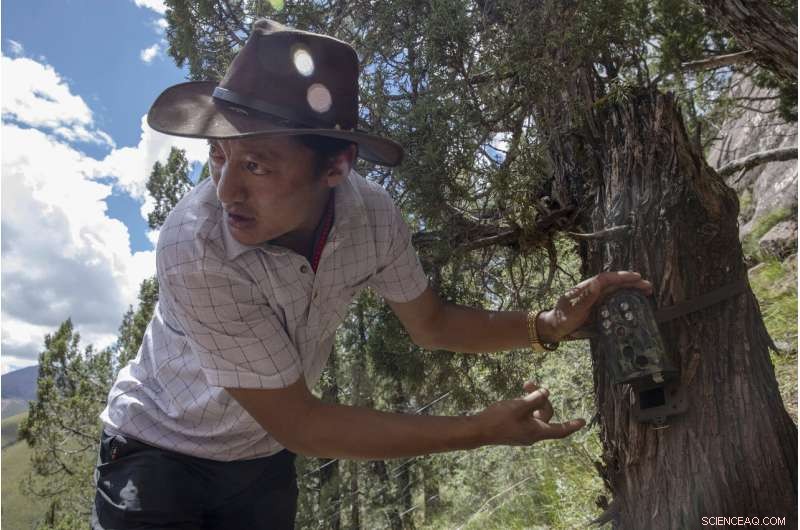
Kunchok Jangtse positions a camera trap in Angsai, an area inside the Sanjiangyuan region in western China's Qinghai province on Tuesday, 27 août 2019. The Tibetan herder also has a job installing and maintaining the motion-activated cameras, which help scientists monitor endangered species in the area. "Our religion is connected with wild animals, because wild animals have a consciousness and can feel love and compassion—therefore, we protect wild-animals, " he says. (AP Photo/Ng Han Guan)
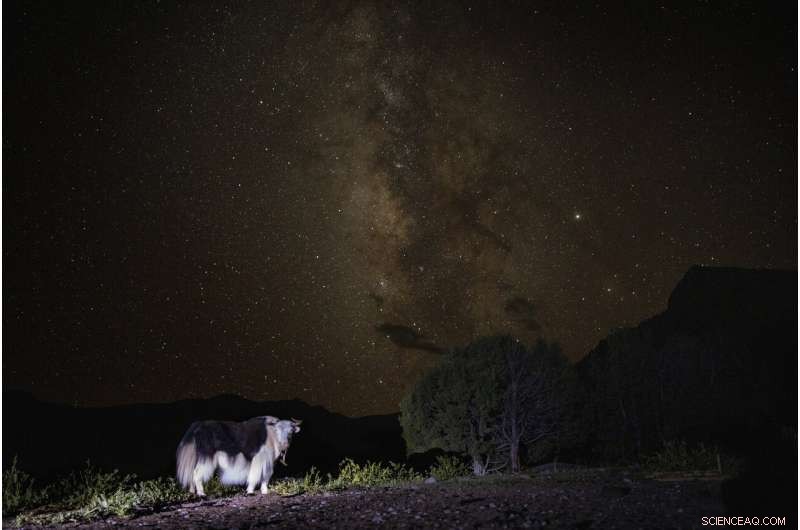
The Milky Way glows behind a yak in Angsai, an area inside the Sanjiangyuan region in western China's Qinghai province on Monday, Aug. 26, 2019. "This is one of the most special regions in China, in the world, " says Lu Zhi, a Peking University conservation biologist who has worked in Qinghai for two decades. (AP Photo/Ng Han Guan)
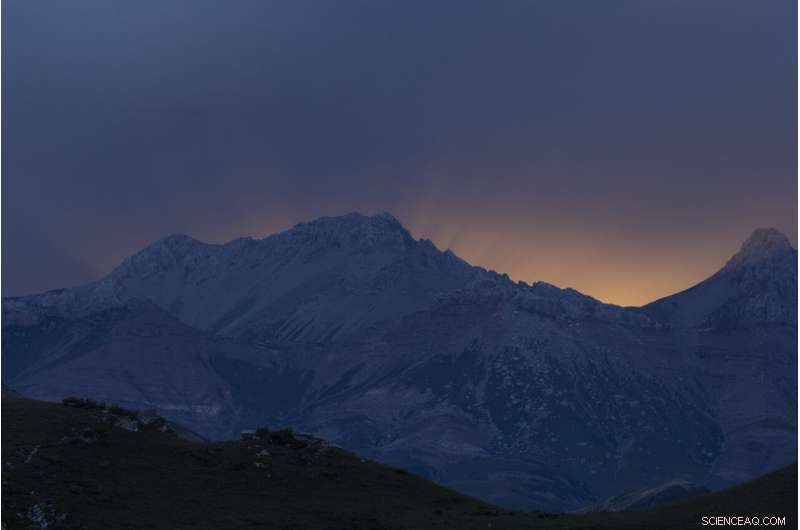
A sunset casts rays of light over the top of a mountain range in Angsai, an area inside the Sanjiangyuan region in western China's Qinghai province on Monday, Aug. 26, 2019. "This is one of the most special regions in China, in the world, " says Lu Zhi, a Peking University conservation biologist who has worked in Qinghai for two decades. (AP Photo/Ng Han Guan)

A bat flies through a narrow crevice in Wuyishan in eastern China's Fujian province on Tuesday, Aug. 13, 2019. (AP Photo/Ng Han Guan)

A monkey bares its teeth at visitors in an animal shelter that is part of tourist site in Wuyishan in eastern China's Fujian province on Friday, Aug. 16, 2019. (AP Photo/Ng Han Guan)
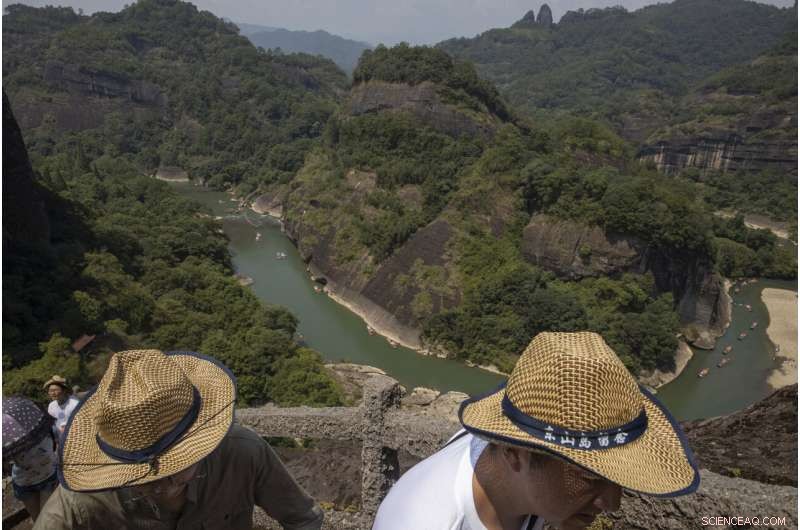
Visitors climb Tianyou peak in Wuyishan in eastern China's Fujian province on Wednesday, 14 août 2019. The ambition to create a unified park system represents "a new and serious effort to safeguard China's biodiversity and natural heritage, " says Duke University ecologist Stuart Pimm. (AP Photo/Ng Han Guan)

Women work on a photo for their tea products on a mountain top in Wuyishan in eastern China's Fujian province on Wednesday, 14 août 2019. Zhu Chunquan, the China representative of the International Union for the Conservation of Nature, a Switzerland-based scientific group, notes that the country's economy has boomed over the past 40 years. But priorities are now expanding to include conserving the country's key natural resources. "It's quite urgent, as soon as possible to identify the places, the ecosystems and other natural features" to protect, Zhu says. (AP Photo/Ng Han Guan)
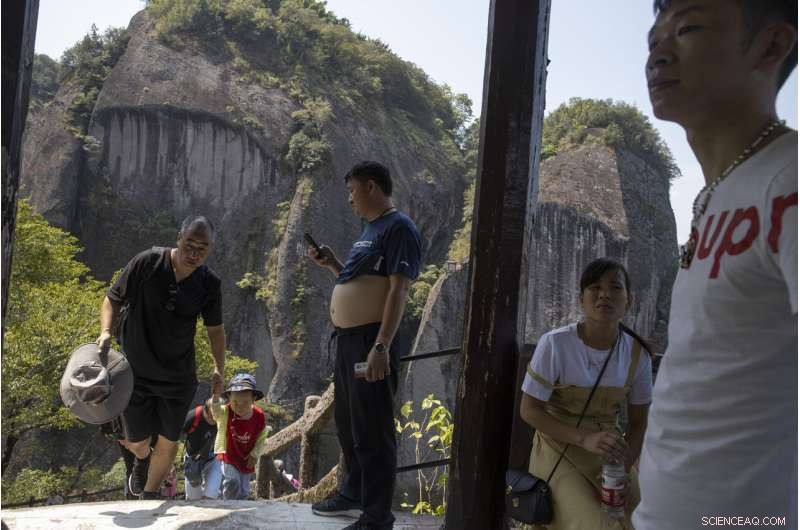
Visitors rest in a pavilion during a climb up Tianyou peak in Wuyishan in eastern China's Fujian province on Wednesday, 14 août 2019. (AP Photo/Ng Han Guan)
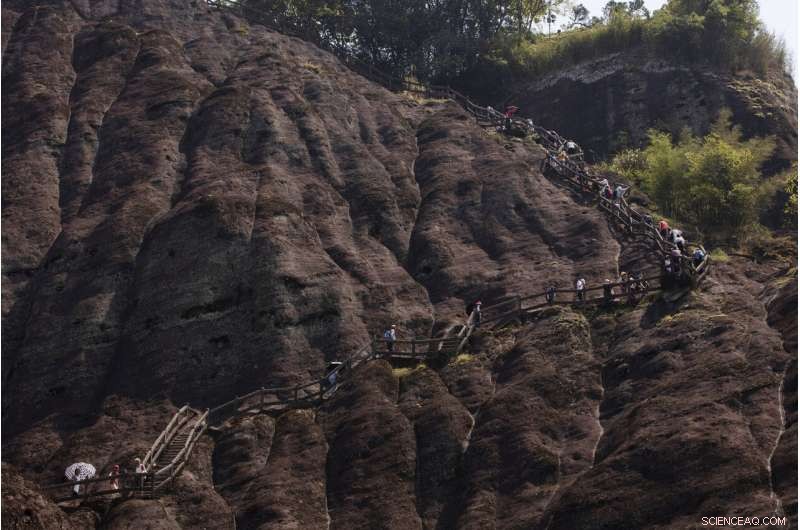
Visitors climb Tianyou peak in Wuyishan in eastern China's Fujian province on Wednesday, 14 août 2019. (AP Photo/Ng Han Guan)
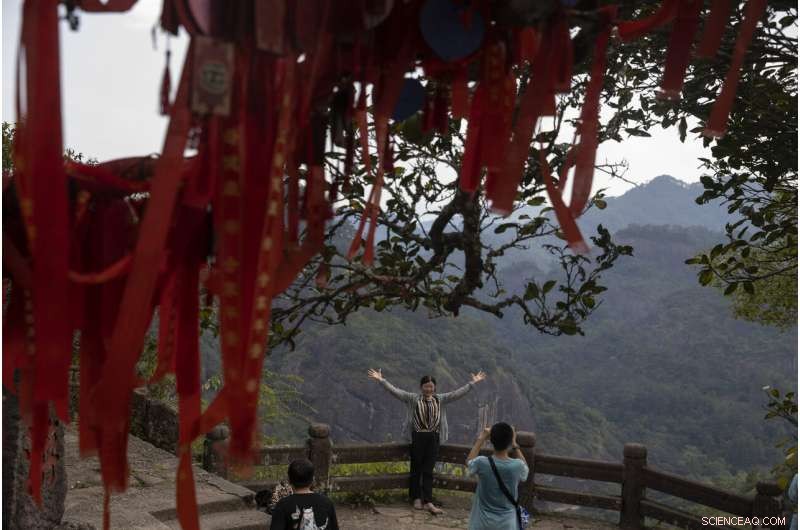
A visitor poses for a photo on Tianyou peak in Wuyishan in eastern China's Fujian province on Wednesday, 14 août 2019. (AP Photo/Ng Han Guan)
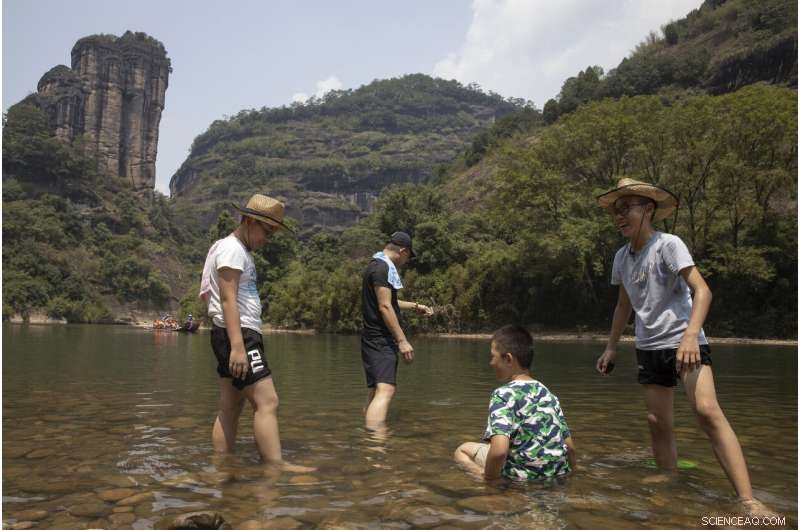
A woman poses for photos near a waterfall in Wuyishan in eastern China's Fujian province on Thursday, Aug. 15, 2019. (AP Photo/Ng Han Guan)

Tourists stand in shallow water along the Nine Bends River in Wuyishan in eastern China's Fujian province on Thursday, Aug. 15, 2019. (AP Photo/Ng Han Guan)
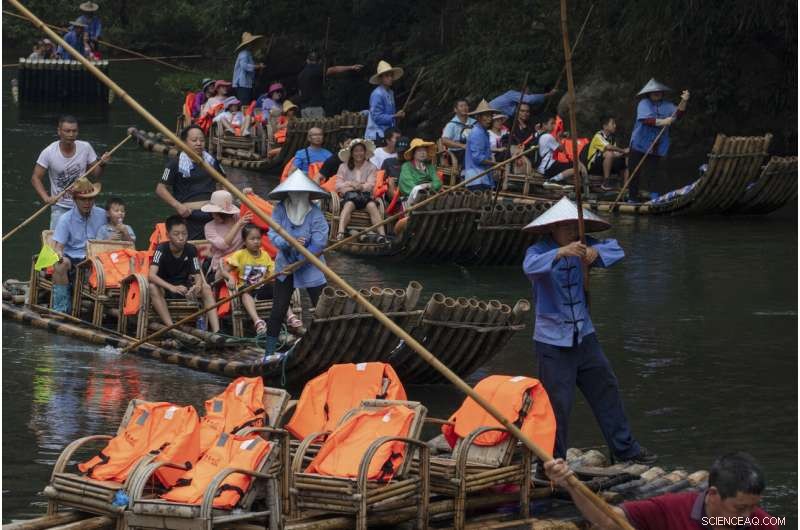
Tourists ride in bamboo rafts during a tour of the Nine Bends River in Wuyishan in eastern China's Fujian province on Thursday, Aug. 15, 2019. In August 2019, policymakers and scientists from China, the United States and other countries met in China to discuss the country's plans to create a unified park system with clear standards for limiting development and protecting ecosystems. (AP Photo/Ng Han Guan)

A boy holds a water rifle on the banks of the Nine Bends River as bamboo raft operators wait for tourists in Wuyishan in eastern China's Fujian province on Thursday, Aug. 15, 2019. Zhu Chunquan, the China representative of the International Union for the Conservation of Nature, a Switzerland-based scientific group, notes that the country's economy has boomed over the past 40 years. But priorities are now expanding to include conserving the country's key natural resources. "It's quite urgent, as soon as possible to identify the places, the ecosystems and other natural features" to protect, Zhu says. (AP Photo/Ng Han Guan)
Now Ouyang is drawing upon that work, combined with surveys of more than 1, 500 species of endangered and threatened plants and animals, to map priority areas for conservation and advise park planners. He is focusing on habitats of endangered species that live only in China.
"If we lose it here, it's gone, " il dit.
The first parks to be formally incorporated into China's national park system will showcase the country's vast and varied landscapes and ecosystems—from the granite and sandstone cliffs of Wuyishan in eastern China to the lush forests of southwestern Sichuan province, home to giant pandas, to the boreal forests of northeastern China, where endangered Siberian tigers roam.
When it comes to ecology, few countries have more to lose, or to save, than China.
"A huge country like China literally determines the fate of species, " says Duke University's Pimm.
© 2019 La Presse Associée. Tous les droits sont réservés.